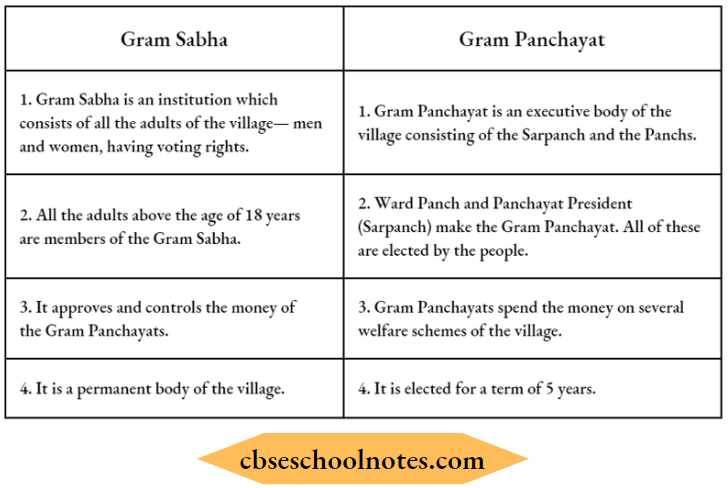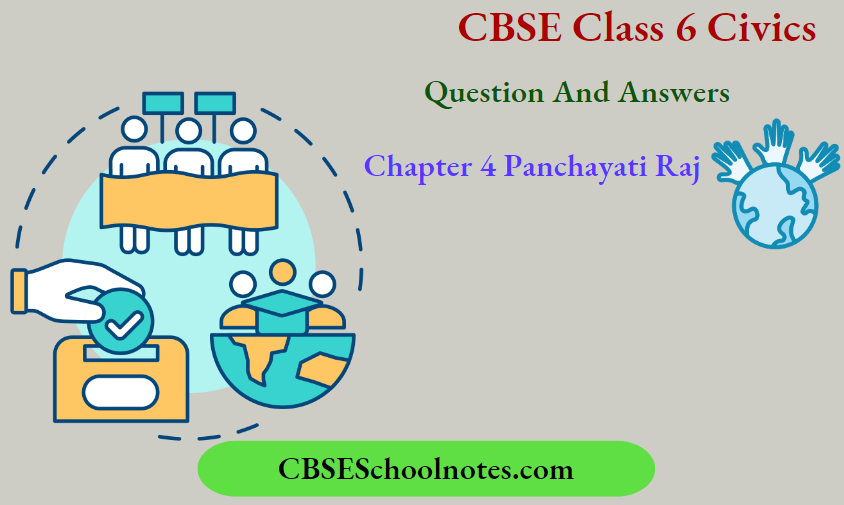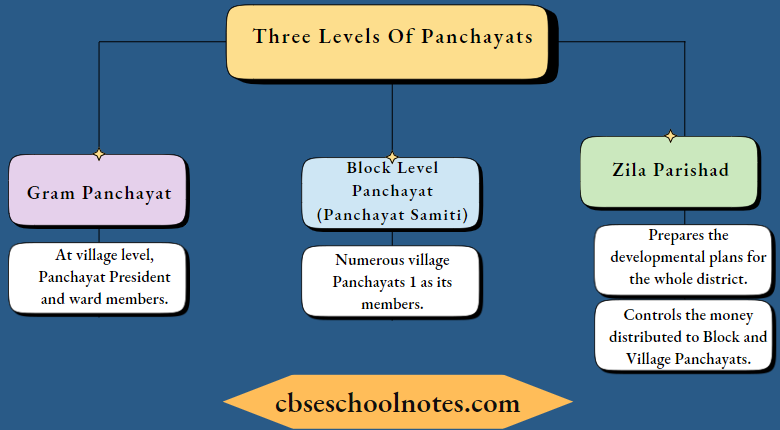Panchayati Raj
Panchayati Raj Facts To Remember
The Gram Sabha is a meeting of all adults of the village or villages in the Panchayat who have voting rights.
- Every village has an elected Panchayat. It is divided into wards. Its term is 5 years.
- Each ward elects a representative—a ward member or Panch.
- Gram Sabha elects the Sarpanch. Sarpanch and Panchs form the panchayat.
- Gram Sabha and Panchayat have a common Secretary. The secretary is appointed by the government.
- The secretary calls the meeting of Sabha and Panchayat.
- Gram sabha keeps a check on Panchayat. The Panchayat carries out the developmental works and collects certain taxes.
- The other two levels of the Panchayati Raj system are—Janpad Panchayat or Panchayat Samiti at the Block level and Zila Parishad at the District level.
Panchayati Raj Keywords

Read and Learn More CBSE Solutions For Class 6 Social Science
Panchayati Raj Exercises
Question 1. What problem did the villagers in Hardas village face? What did they do to solve this problem?
Answer:
The villagers of Hardas village faced a shortage of drinking water.
- They did the following tasks to solve this problem:
- They deepened the two handpumps.
- They cleaned one well.
- They sought information about the scheme of watershed development from the Block Development Officer.
Question 2. What, in your opinion, is the importance of the Gram Sabha? Do you think all members should attend Gram Sabha meetings? Why?
Answer:

All members should attend Gram Sabha meetings because they have to make decisions about the welfare of the village people.
Question 3. What is the link between a Gram Sabha and a Gram Panchayat?
Answer:
Gram Sabha makes the Gram Panchayat perform its role responsibly.
- Gram Sabha consists of all village adults who in turn elect the members of the Panchayat.
- All plans of Panchayat are placed before the Gram Sabha.
- All spending of Government grants is controlled and approved by the Sabha.
- It prevents the misuse of funds or favoritism in Panchayat.
- It makes the elected representatives (Panch) responsible.
Question 4. Take an example of any one task done by a Panchayat in your area or nearby rural area and find out the following:
- Why was it taken up?
- Where does the money come from?
- Whether or not the work has been completed?
Answer:
The task was taken up: Repair of drains.
- It was taken up because the drains were in damaged condition. Dirty water was spreading in the streets and on the roads.
- The money came from taxes, government grants, and donations.
- The work has been completed.
Question 5. What is the difference between a Gram Sabha and a Gram Panchayat?
Answer:
Difference between a Gram Sabha and a Gram Panchayat.

Question 6. Read the following news item:
Nimone is a village on the Chauphula-Shirur Road. Like many others, this village has also been facing a severe water shortage for the last few months and men were against this and told him that the tanker water was not meant for the lower castes. Adapted from Indian Express, May 1, 2004
- Why was Bhagvan beaten?
- Do you think that the above is a case of discrimination? Why?
Answer:
- Bhagavan was beaten because he insisted that water from the tanker be emptied into the storage tanks.
- He belonged to a lower caste.
- Yes, I think that the above is a case of discrimination. The upper caste people did not like the suggestion of lower caste Bhagavan, though his suggestion was very appropriate. It would have helped in solving the water shortage in the village.
Question 7. Find out more about watershed development and how it benefits an area.
Answer:
Watershed development helps in conserving water and recharging the groundwater.
- Under this scheme, the following tasks are performed.
- Trees are planted,
- Check dams and tanks are constructed to harvest rainwater.
- An ample quantity of water is available both for drinking and irrigation.
- Barren lands are turned into green meadows.
- Arable land is reclaimed.
Question 8. What happens after people elect their representatives?
Answer:
After people elect their representatives, the elected representatives elect their leader.

Question 9. How are decisions made?
Answer:
- The majority party puts the proposal about an issue.
- The issue is discussed in the Gram Sabha.
Question 10. How does this take place in rural areas?
Answer:
- In rural areas, the Gram Sabha meets in the form of a meeting.
- People participate in the Sabha.
- The elected representatives answer the questions asked directly by the people.
Question 11. It is a special day today! Everyone is rushing to get to the Gram Sabha! Do you know why?
Answer:
Yes, we know,
- The Gram Sabha is holding its first meeting after the election of the new Gram Panchayat.
- The people want to know what the new panchayat leaders have planned for the village.
Question 12. Answer the following questions based on the text:
- Was there a problem with the BPL list that Gram Sabha was finalizing? What was this problem?
- Why do you think Soorajmal kept quiet even though Saroja asked him to speak?
- Have you seen any similar incidents when people are unable to speak for themselves? Why do you think that happened and what prevented the person from speaking?
- How can the Gram Sabha prevent the Panchayat from doing what it likes?
Answer:
- Yes, there was a problem with the BPL list that the Gram Sabha finalizing. The problem was that Natwar and Biiju were listed in the BPL list but they were not eligible for this. Om Prakash, who was eligible for the BPL list, was not listed in this BPL list.
- Soorajmal kept quiet even though Saroj asked him to speak for the following reasons:
- Soorajmal was under the influence of Amirchand.
- Amirchand was present in the meeting of the Gram Sabha.
- Amirchand’s influence prevented him from speaking.
- Yes, there are several occasions, when I want to ask any question in my class, but I could not ask.
- The reason was due to shyness or hesitation.
- Gram Sabha can prevent the Panchayat from doing what it likes:
- By observing the meeting and getting the accounts of the Panchayat checked and scrutinized.
- All the works of the Panchayat have to be approved by Gram Sabha. It would not approve wrong works done by the Panchayat.
Question 13. What was the Hardas Gram Panchayat able to do?
Answer:
The Hardas Gram Panchayat was able to do the following tasks:
- To deepen two handpumps.
- To clean one well
Question 14. Do you remember the options that were suggested to solve the water problem in the Gram Sabha of Hardas village?
Answer:
Yes, we remember.
The options suggested were:
- Piping water from Suru river which was 3 kilometres away from the village.
- Making an overhead tank in the village to increase the water supply.
- Deepening of the handpumps.
- Cleaning the village well for that season.
- Watershed development for conserving and recharging the groundwater resources.
Question 15. . Gram Panchayat members first discussed the suggestion to deepen two that the Gram Panchayat would approach the Block Development Officer and get more information on the scheme.
- What decisions were taken by the Gram Panchayat?
- Do you think they needed to make these decisions? Why?
- From the above description, write down one question that people could ask of the Panchayat in the next Gram Sabha meeting.
Answer:
- The following decisions were taken by the Gram Panchayat:
- To deepen two handpumps.
- To clean one village well.
- To approach the Block Development Officer (BDO) for information (detailed) about the scheme of watershed development.
- Yes, we think they needed to make these decisions. Drinking water shortage was the most important problem for the entire village.
- In the next meeting, members could ask: for information obtained from the BDO regarding the watershed development scheme.
Panchayati Raj Very Short Type Questions And Answers
Question 1. Who is a Sarpanch?
Answer:
Sarpanch is the Panchayat President. He is elected by the members of Gram Sabha.
Question 2. Why Nirmal Gram Puruskar is awarded?
Answer:
Nirmal Gram Puruskar is awarded for excellent work done by a Village Panchayat.
Question 3. What are the functions of Zila Parishad?
Answer:
The functions of Zila Parishad are:
- Developmental plans and works at the district level.
- Regulates the money distribution at the Samiti and Panchayat levels.
Question 4. Why name of Om Prakash was not included in the BPL list?
Answer:
When the teacher, who surveyed BPL, went to the house of Om Prakash, it was locked.
Panchayati Raj Short Type Questions And Answers
Question 1. In some states Gram Sabhas form committees. Name the committees.
Answer:
In some states, Gram Sabhas form committees to carry out specific works.
- A construction committee is formed to carry out the construction work.
- The development committee is engaged in development work.
- Construction, water supply, drainage.
- These committees are composed of some members of Gram Sabha and some members of the Gram Panchayats.
- They work together to carry out specific tasks.
Question 2. Enumerate the works of Gram Panchayats. What are the sources of funds of Gram Panchayats?
Answer:

Question 3. Describe the three levels of Panchayats.
Answer:
The Panchayati Raj System is a process through which people participate in their government.
There are three levels of Panchayats:
- Gram Panchayat.
- Block level Panchayat (Janpad Panchayat or Panchayat Samiti)
- District Panchayat or Zila Panshad.

Panchayati Raj Long Type Questions And Answers
Question 1. Describe the composition of the Gram Panchayat.
Answer:

Panchayati Raj Multiple Questions And Answers
Question 1. Where do people directly participate and seek answers from their elected representatives?
- Gram Sabha
- Parliament House
- Both (1) and (2)
- None of these
Answer: 1. Gram Sabha
Question 2. Who is called the Sarpanch?
- Member of Panchayat
- Villagers
- Panchayat Head
- All of these
Answer: 3. Panchayat Head
Question 3. The member of Panchayat is also called
- Member of Parliament
- Panch
- Prime Minister
- None of these
Answer: 2. Panch
Question 4. Who elects the Panchayat Head?
- All members of Gram Sabha
- Villagers
- Secretary
- All of these
Answer: 1. All members of Gram Sabha
Question 5. Who appoints the Secretary of Gram Panchayat?
- Government
- Ordinary person
- Election Commissioner
- Landlord of village
Answer: 1. Government
Question 6. From where do the village women have to get water?
- Suru river
- Ganga river
- Yamuna river
- Gomati river
Answer: 1. Suru river
Question 7. Who is responsible for calling the meeting of the Gram Sabha?
- President of Gram Sabha
- Panchs of Gram Panchayat
- Secretary of Gram Sabha
- None of these
Answer: 3. Secretary of Gram Sabha
Question 8. Whose names should be included in BPL families?
- Very poor person
- Middle family person
- High-income group
- All of these
Answer: 1. Very poor person
Question 9. What are the works of Gram Panchayat?
- Maintenance of village roads
- Maintenance of village schools
- Collection of local taxes
- All of these
Answer: 4. All of these
Panchayati Raj Objective Type Questions And Answers
Question 1. Fill in the blanks with appropriate words:
(1). The people of Hardas village were facing the problem of _________.
Answer: water shortage
(2). The Panchayat gets the funds from donations, taxes, and __________ the developmental works.
Answer: Government grants
(3). Panchayat is answerable to the __________.
Answer: Gram Sabha
(4). Village panchayat is divided into ____________.
Answer: Wards
Question 2. State whether the given statements are true or false.
(1). Work of the Gram Panchayat is approved by Zila Parishad.
Answer: False
(2). Gram Panchayat is elected for a term of five years.
Answer: True
(3). Watershed development may be a solution to the problems of the people of Hardas village.
Answer: True
(4). The full form of BPL is Below the Power Line
Answer: False
Question 3. Match the contents of Column A with that of Column B.

Answer: 1-(d), 2-(a), 3-(b), 4-(c)
